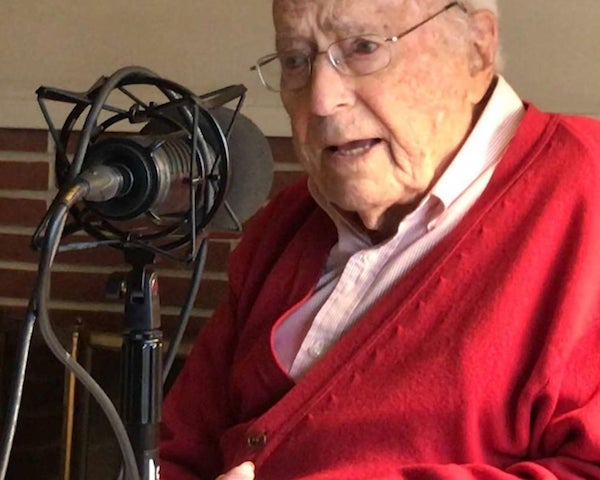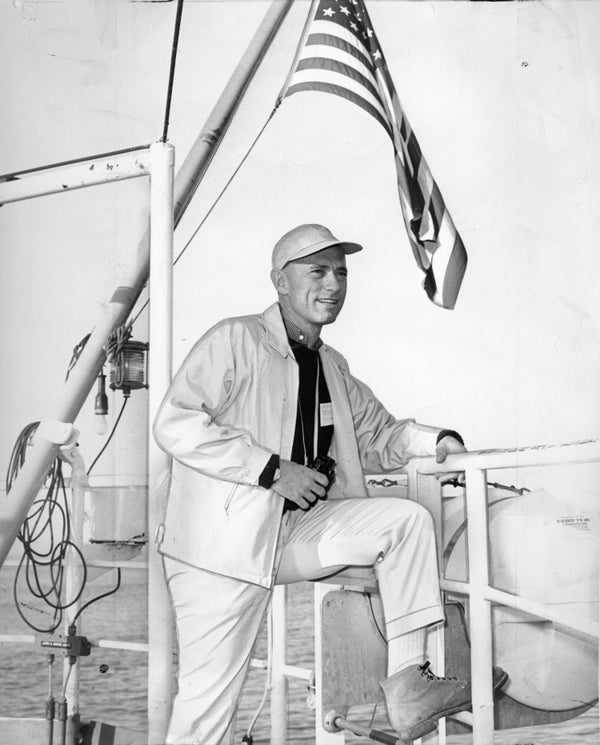This article was published in Scientific American’s former blog network and reflects the views of the author, not necessarily those of Scientific American
The world will sorely miss the wit and wisdom of David Perlman, long admired as the senior statesman of American science writing, who passed away on June 19, 2020, at age 101. He was born during the 1918 flu pandemic and died in the midst of the COVID-19 pandemic. The former San Francisco Chronicle reporter and science editor emeritus was remarkable not only for his longevity—including more than seven decades in the news business—but for the extraordinary breadth of his coverage, from space shots to fossil remains, women’s reproductive health and nuclear disarmament.
Dave’s enthusiasm for each story was infectious; his curiosity about all things science was limitless. He entertained and informed generations of newspaper readers and inspired a cadre of American journalists to cover the wonders of science, as well as its influential—and sometimes controversial—role in modern society. I was one of the many “kiddos” fortunate enough to know Dave, first as a mentor and then as a lifelong colleague and friend.
I called him regularly, and, in recent months, he always answered with a cheerful, "I'm still alive." Wheelchair-bound in his longtime San Francisco home, Dave avidly followed newspaper and cable news coverage of the COVID-19 crisis. We reminisced about Tony Fauci, the widely admired government infectious disease guru on the White House Coronavirus Task Force who has often disagreed publicly with President Trump. We had both gotten to know Fauci while reporting on HIV/AIDS in the 1980s. "I hope he can survive under Mr. Trump. We are safer with him there," he said.
On supporting science journalism
If you're enjoying this article, consider supporting our award-winning journalism by subscribing. By purchasing a subscription you are helping to ensure the future of impactful stories about the discoveries and ideas shaping our world today.
We also talked recently about one of the “greatest problems” facing American science: the rise of public denialism and its impact on all areas of research, from climate change to evolution. Those who distrust scientists and deny scientific findings “are increasing in power, and their voices are growing louder. That worries me a lot,” he said, noting the damaging effect of President Trump’s anti-science stance, particularly on climate science research.
When Dave retired in August 2017, at age 98, he "was thought to be the oldest full-time reporter in the U.S.," according to the Chronicle. Known in the newsroom as "Dr. Dave," his retirement party drew colleagues, friends, scientists, the late San Francisco mayor Ed Lee and U.S. Senator Dianne Feinstein. Dave began as a copyboy for the paper in 1940, after a starter newspaper job in Bismarck, North Dakota and also had a postwar newspaper stint in Paris before returning to the Chronicle. “I still get the Chronicle every day. I wouldn’t miss it. And I will continue subscribing to the Chronicle until the day I die,” he said in a 100th-birthday interview on the Chronicle’s podcastThe Big Event. With characteristic humor, he added, “Maybe there’s a way of sending it to the afterlife; I don’t know whether there is a posthumous edition. If there is, I will be reading it.”

David Perlman on a podcast in celebration of his 100th birthday. Credit: Peter Hartlaub San Francisco Chronicle
Last November, the American Geophysical Union (AGU) announced that Dave would receive its 2019 Presidential Citation for Science and Society, in a year in which AGU and the award recipient were both 100 years old. The award “celebrates David’s stellar work but also the role he has played in mentoring and inspiring generations of science journalists,” said AGU’s executive director Chris McEntee. AGU earlier created the David Perlman Award for Excellence in Science Journalism–News—an honor made more desirable because of its namesake.
Throughout his career, Dave earned the trust of scientists for his fair, insightful reporting. He enjoyed extraordinary firsthand access to research in the lab and the field, with globe-trotting adventures that would be envied by today’s time- and money-starved science journalists. In 1964 he boarded the California Maritime Academy’s training ship Golden Bear with dozens of international scientists for a two-month expedition (two months!) to study the evolution of plants and animals in the Galápagos Islands. He covered countless NASA missions, reporting from Houston on the historic moon walk by American astronauts on July 20, 1969. He spent two weeks in Antarctica with the National Science Foundation in 1972. And at age 87, he camped in Ethiopia with a University of California, Berkeley, team searching for fossils of human ancestors.
Closer to home, Dave covered the tragedy of HIV/AIDS, as the deadly epidemic unfolded in San Francisco in the 1980s and, later, as new lifesaving treatments became available to patients. He wrote about genetic engineering techniques pioneered in laboratories around the Bay Area, as well as companies that capitalized on their findings. Earthquake research was de rigueur on the California science beat.
I came to know Dave when I was a biology student at Mills College in Oakland, Calif., in the early 1970s. I concluded I didn’t have the patience—or persistence—to become a scientist but loved writing for the college newspaper. I found Dave’s byline as the Chronicle’s science correspondent at the library, cold-called him and then visited him at the paper. After one conversation, I knew I wanted to be a “Perlman.”
Little did I know then that I had struck it rich—that this smart, funny and very kind man was already a superstar among science writers. I was even more fortunate to see Dave in action when I covered the historic February 1975 Asilomar recombinant DNA conference in California for the journal BioScience. Dave and other national science reporters asked hard questions about the science, safety and ethical concerns surrounding the then new technique to cut and splice DNA into organisms.
Other Dave sightings continued after I got my first newspaper job at the Washington Star. We spent weeks at NASA’s Jet Propulsion Laboratory in Pasadena, Calif., covering the first landing of a spacecraft on Mars in the July 20, 1976 Viking mission, as well as experiments looking for life on the Red Planet. I was fortunate to be part of the Perlman-led delegation of U.S. science writers that visited China in 1979, after the Mao-era Cultural Revolution ended. We started in Beijing, took an overnight train to the countryside to see a rudimentary factory and then went on to Shanghai and Guangzhou, talking with elderly Chinese scientists about everything from aquaculture to acupuncture. On a November, 2019 visit to Dave’s home on San Francisco’s 5th Avenue, we reminisced about that trip: he recalled buying a box of Chinese birth-control devices to take back to Carl Djerassi, the late Stanford University chemist known as “the father of the birth-control pill.”
Dave was a New Yorker, raised on Manhattan’s Upper West Side, who was inspired at a young age to become a newspaper reporter after seeing the play The Front Page. He graduated from Columbia College in 1939, spending much of his time reporting and editing the student newspaper the Columbia Daily Spectator (you can read a great Perlman piece on a New York parade in the Spectator’s onlinearchive)and went on to earn a graduate degree from the Columbia Journalism School in 1940. In a video interview I did with Dave in 2009, he talked about preparation for a science writing career, saying, “I guess the best advice I could give is try to learn a little more science before you start than I ever had when I started.” He added, “As a matter of fact one of my colleagues ... was good enough to teach me and tell me what DNA stood for. And when I heard ‘deoxyribonucleic acid,’ I nearly fell over ’cause I’d never heard of the stuff. But I learned.”
In another interview we did, he advised learning “how to ask questions and how to make people explain the answers. Never be ashamed or afraid to pursue something that you don't understand. And then come prepared with as much background as you can possibly get. It means reading ... I don’t know, Mars for Dummies or something that is highly technical, if you can. But prepare yourself.” In one of his first medical stories, he heard the term “bilirubin” (a compound made during the break down of red blood cells) and assumed it was the name of a patient, Billy Rubin, before discovering what it actually meant.
Dave got interested in science writing in the late 1950s, after being given a book called The Nature of the Universe, by astrophysicist Fred Hoyle. He was hooked after he met a local astronomer and asked what he did for a living. “He said he studied stars that are born in the Orion Nebula. I thought, ‘My God, what an epiphany. Imagine stars being born—a pregnant nebula.’ I wrote a whole story about that. I didn’t use the word pregnancy either. But that was the start of everything,” Dave recalled.
It was good timing, with the space race underway after the Soviet Union launched Sputnik 1, the first artificial Earth satellite, on October 4, 1957. He had to start science writing from scratch, with the most basic “how” and “why” reporter’s questions: How do you launch a small metal sphere into orbit around the Earth, and why doesn’t it just fall from the sky? Basic, even humble, questions equal great science writing for the general public.
The universe is what intrigued Dave to the very end. I once asked him what he wished he could cover as a reporter in the years ahead. The quick answer was: “Distant space and all that implies—looking at exoplanets and implications for the future of life itself.” Closer to home, Dave said he would also want to write about “the newest approaches to human disease and public health.”
Dave was the ultimate mentor. Over the decades, I repeatedly saw him talking to young reporters or speaking to science journalism students. Dave spawned many science writers, as well as mentors of future science writers. Early in my career, he urged me to sponsor an American Association for the Advancement of Science mass media intern, the son of a Chronicle friend, for a summer at the Washington Star. I barely knew what I was doing, but yes, Dave prevailed—the intern was Richard Harris, who went on to a distinguished science journalism career at NPR.
Dave also did service to science writing as president of the National Association of Science Writers (1970–1971) and, later, of the Council for the Advancement of Science Writing, or CASW (1976–1980). He was always trying to improve science journalism, including making CASW-sponsored “home” visits to local newspapers, where he talked to reporters, editors and publishers about why covering science was important.
In 2017, U.S. science writers created the David Perlman Travel Fellowships in his honor, making more than $40,000 in personal donations to support international colleagues coming to the World Conference of Science Journalists in San Francisco.
Dave defied the odds until the end. He had a blood cancer called myelodysplastic syndrome (MDS), and went into hospice care last fall after deciding to discontinue blood transfusion treatments. His doctor expected he would die in a matter of weeks. Instead he lived for another eight months.
About now, I can hear Dave’s voice in my ear saying, “Enough already.” Despite the many accolades he received, Dave had limited tolerance for personal praise. There has never been a newspaper science reporter as in love with his craft—or as good at it—as Dave Perlman. I’m among the many who owe him a tremendous debt of gratitude and will miss him greatly. When we last talked, he urged me to come visit on my next trip to the West Coast and ended with a cheerful "goodbye kiddo."
Goodbye to you too, kiddo. It's been swell.
